KLRU Online Fundraising: Lessons Learned Over 3 Years
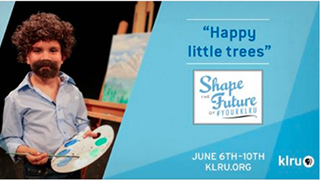
KLRU Online Fundraising: Lessons Learned Over 3 Years

From infancy to toddlerhood, over three years, we’ve learned that 1) online drives produce higher retention than new acquisition, 2) multichannel fundraising increases opportunity for success and 3) successful peer-to-peer fundraising requires creativity, effort and promotion.

Starting in June of 2015, Austin’s KLRU has held a five-day, online-only fundraising drive every summer – replacing the previous 10-day on-air drive that interrupted the regular schedule and broke into programming with pledge messaging. The campaign had built-in crowdfunding techniques that included peer to peer fundraising, social media and email campaigns along with the use of urgency and incentives.After three years, we asked Susannah Winslow, KLRU’s membership director, to tell us what she’s learned in the process.
“We’re evolving the campaign every year,” she says. “I feel like I’ve taken it from infancy to toddlerhood and it’s going to continue to grow.”
The first year was built around the hashtag #YourKLRU. “It was our first online-only drive. We wanted to raise $50,000 in five days using peer-to-peer fundraising and giving-day techniques. We used email marketing and social media to get people talking about us and why they support us,” says Winslow. The station also promoted the campaign with a few on-air spots during the five days and the weeks leading up to it. But the spots were mostly an afterthought. “We didn’t put a lot of time, energy or strategy into them.”
Still, the 2015 campaign nearly doubled the goal, raising more than $94,000 with an average gift of $91. Afterward, KLRU surveyed donors to find out what pushed people to give. “The majority of the gifts were either because they saw an on-air spot or they got an email about it,” she says.
2016 Transitioned to an omni-channel campaign
So for 2016, KLRU decided to put more effort into promoting the online drive on-air. “We made this cute campaign around shaping the future of your KLRU and had a bunch of kids dress up as Bob Ross and Julia Child,” she says. That year’s campaign took a multi-channel approach, adding direct mail to the email and social media elements. “We kept the branding and messaging consistent across the board,” says Winslow. With a $100,000 goal over five days, it ended up raising $119,000. Around 70 percent of that total came from online gifts, with the rest contributed via mail. The average gift amount increased to around $130.
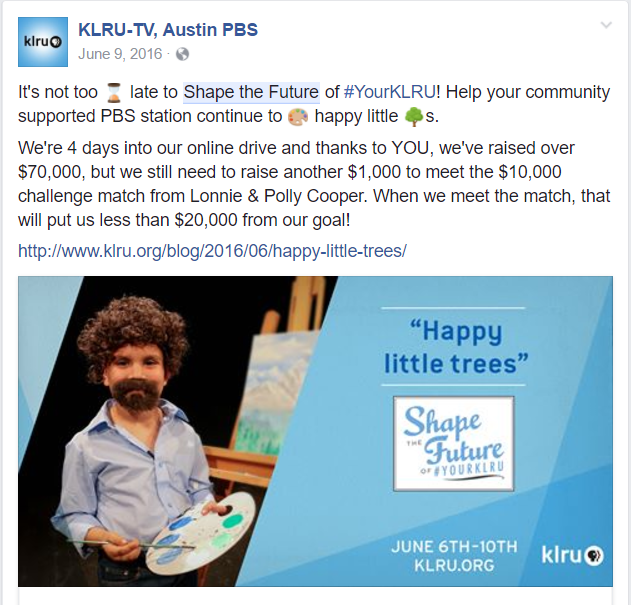
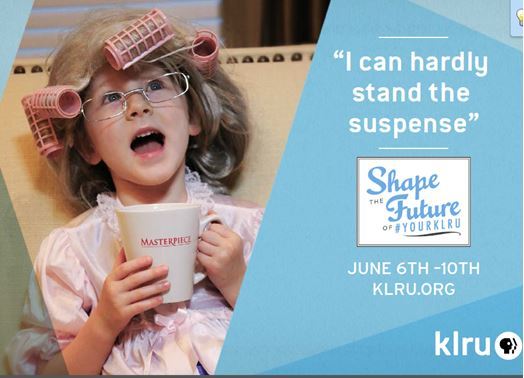
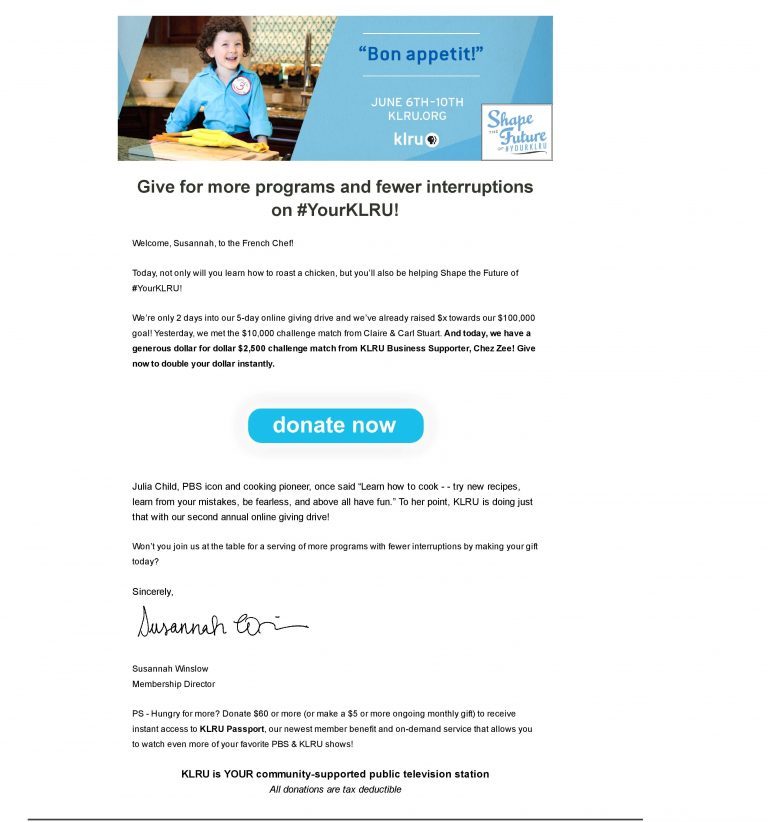
Though social media played a big role in 2015, that response faded in 2016. “Momentum was down,” she says. “There weren’t a lot of people talking and sharing on social media about it. It was like we created all these cute spots but no one could interact with us about them.” While the community advisory board had gotten excited during the first year’s campaign, their peer-to-peer fundraising lagged in Year Two. “It was like ‘We’ve already done this before.’ They didn’t feel the urgency to grab on and make the campaign a social campaign again.” With ten different spots featuring the children, KLRU also struggled to manage the messaging and visuals.
2017 Incorporated digital ads and focused on the value of public television
Still, the 2016 campaign was a success, and KLRU used it as a springboard for this year’s approach. For 2017, Winslow and team built the fundraising around program pages so donors could feel like they were giving directly to the programs they love and support. “We wanted to bring the social aspect back to the campaign, so we called it ‘What’s Your KLRU?’ We wanted to get people talking, especially with the federal funding issue happening,” she says.
Creating the social media hashtag #YourKLRU, the station encouraged viewers to speak about the value of KLRU and even recorded testimonials of how it had impacted community members. “A few different stories really stood out,” says Winslow. “One was a mom who said ‘KLRU and PBS are how I learned English and now it’s how my daughter sharpens her budding kindergarten skills.’ We are highlighting our actual viewers’ words.”
KLRU added IP targeting to this year’s campaign, placing digital ads and boosting Facebook posts. “People were seeing it everywhere.” Results showed that the ads didn’t necessarily make people more inclined to give, but increased their average gift amount.
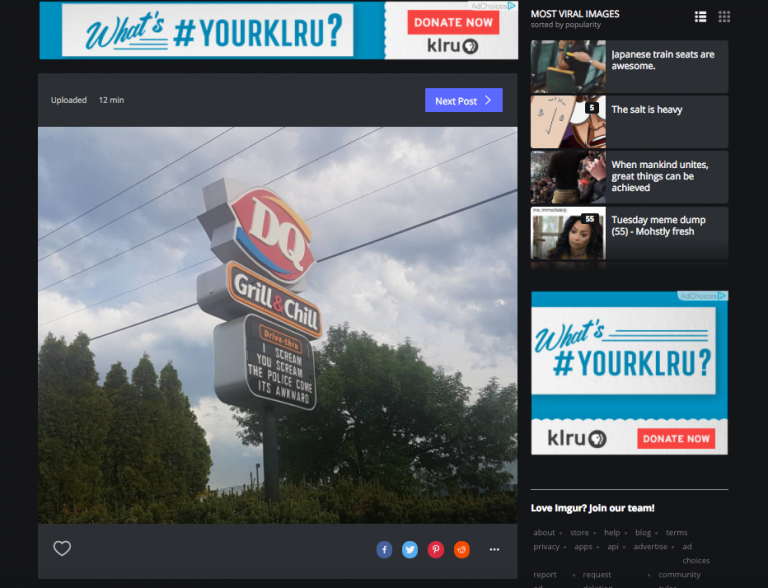
Having set another goal of $100,000 over the multichannel five-day campaign, KLRU raised $110,000. “About 60 percent of the total was raised online and the rest was through the mail,” she says. “Peer-to-peer was a challenge again. It’s hard to get people to do it.” The most peer-to-peer fundraising success came from KLRU staff members.
Looking back at all three years, Winslow says the online campaign was strongest as a member retention campaign. Around half of the funds each year were renewals and additional gifts, with only 20 percent representing new members. “It’s definitely a retention campaign more than an acquisition campaign,” she says. Moving forward, she and the KLRU team are strategizing about how to bring in more new members and reach out to a new audience.
Looking to the future – more fun and internet-y
They intend to start by employing more FB live videos. “We had good results on the days we went live, asking for support and doing something fun and internet-y,” she says. In one video, KLRU staff tried to sing songs on the Austin City Limits stage while using a voice-modifying Speech-Jammer app. It attracted attention. “Next year, we’ll think a little bit more about coming up with fun Facebook live videos like that—maybe one a day during the campaign.”
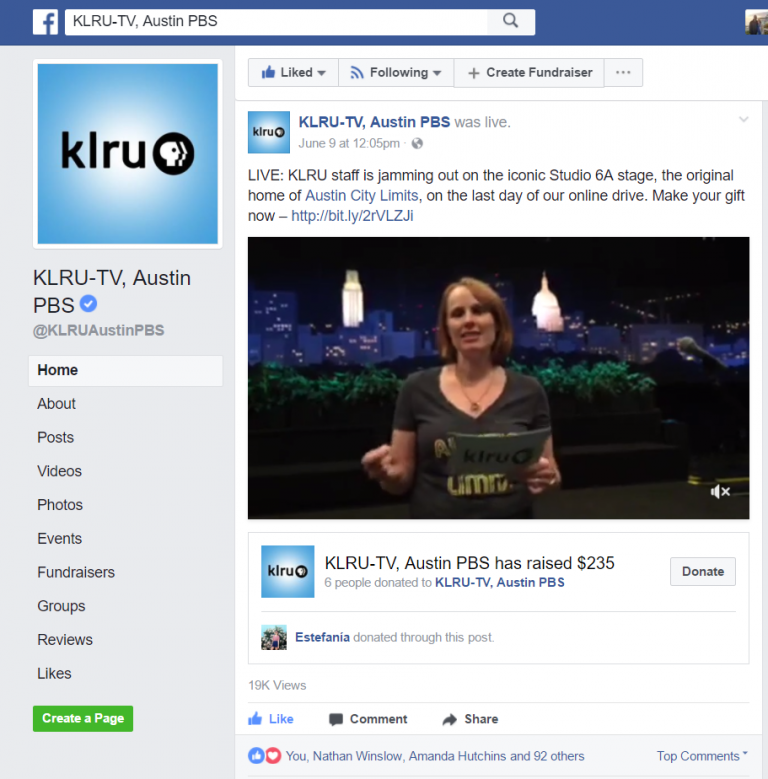
She says those kinds of videos aren’t just entertaining for viewers. They get staff excited about the campaign, too. “They get behind it because it’s fun and cool. It makes it a lot easier for them to share with their networks on social media.”
Questions about the campaign? Contact Susannah Winslow at swinslow@klru.org or Tracy Ferrier at tbferrier@pbs.org
